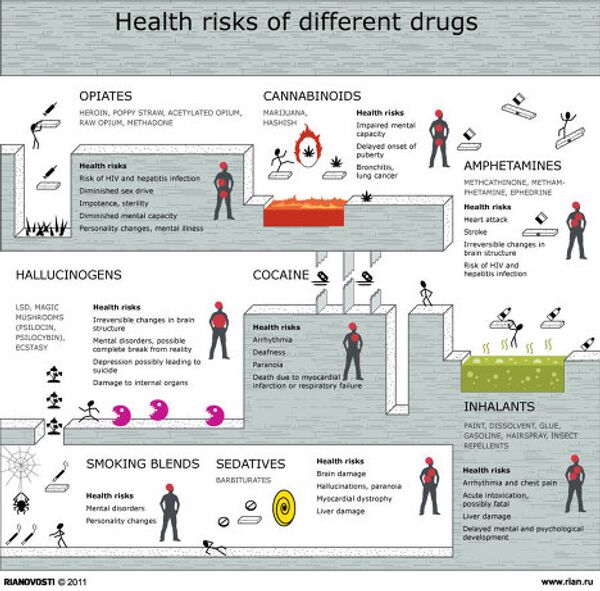MOSCOW, June 26 (RIA Novosti) – Governments across the world face a new and rapidly growing threat from legal psychoactive drugs, according to a new UN report released on Wednesday.
While the use of traditional drugs is still widespread, though more stable, in some parts of the world, the new psychoactive substances - also known as “legal highs” and “designer drugs” - can pose an even greater danger, the United Nations Office on Drugs and Crime report stated.
“This is an alarming drug problem - but the drugs are legal. Sold openly, including via the Internet, NPS [new psychoactive substances], which have not been tested for safety, can be far more dangerous than traditional drugs,” the UN agency said in a statement.
New psychoactive substances are substances of abuse not controlled by the UN basic conventions on narcotic drugs and psychotropic substances that pose a public health threat, the World Drug Report 2013 said. The report shows that the number of such substances “rose from 166 at the end of 2009 to 251 by mid-2012, an increase of more than 50 percent.”
Data on seizures shows that the new psychoactive phenomenon has been spreading worldwide, reaching Asia, Eastern Europe and Russia, among others. In total, some 70 out of 80 countries reported the emergence of new psychoactive substances.

Other Drug Problems
The production and use of traditional narcotics has been stable in recent years, though a high prevalence of opiate use has been documented in southwest and Central Asia, eastern and southeastern Europe and North America, the report said.
In addition, methamphetamine manufacture is still spreading, with new sites uncovered in Poland and Russia.
Afghanistan’s opiates production, which accounts for 74 percent of the world’s estimated output in 2012, remains one of the key global drug problems highlighted by the UNODC. Preliminary reports from Afghanistan suggest a further expansion of illicit opium cultivation in 2013.
The UN agency notes Afghanistan has "a global total of over 236,000 hectares under cultivation, and the local illicit cultivation of opium poppy reached peak levels in 2012, surpassing the ten-year high recorded in 2007."
The reported data indicates that more Afghan opiates are being trafficked on routes other than the Balkan route and the northern route (through Central Asia and Russia), but also on other routes collectively known as the “southern route” south from Afghanistan, either through Pakistan or Iran.
Overall heroin seizures in Central Asia have been declining since the first decade of the 21st century “from an annual average of 5 tons per year during the period 2002-2006 to only 3 tons during the period 2007-2011.” Nevertheless, demand for heroin in Central Asia and Russia is seen to be stable or increasing, it said.

“The small peak in seizures in 2008 seems to reflect the high opium production in Afghanistan in that and the preceding year, but did not change the overall declining trend,” the report concluded. It conceded, however, that “the link between production in Afghanistan and seizure levels in Central Asia is not evident and other factors are assumed to have played a role.”
David Lewis, senior research fellow in the Department of Peace Studies at the University of Bradford, has previously suggested that with the increase of drug production in Afghanistan, exports through Central Asia have probably risen even more, but local drug traffickers receive protection from the top in the governments of former Soviet states - the factor that directly influences the fall in seizures.
Injecting Drug Use in Russia
The number of people injecting drugs saw a notable increase in several countries including Russia, Pakistan and Vietnam, the report said.
Russia, the United States and China account for 46 percent of the global number of people living with HIV infection who inject drugs, the report said.
In Russia alone, the number of adult injecting drug users (mainly heroin) rose by over 500,000 between 2008 and 2011, according the report. The rise means that Russia’s rate of injecting drug use is 2.3 percent of the adult population (more than three-and-a-half times higher than the global average).
Although the availability of heroin has decreased in Russia, that has led to heroin’s “partial replacement with local and readily available substances such as acetylated opium (as in neighboring Belarus) and with desomorphine, a homemade preparation made from over-the-counter preparations containing codeine.”



